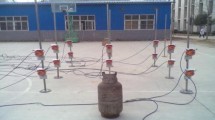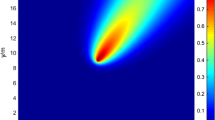Abstract
Gas leakage source localization based on sensor networks has an important practical significance in many fields such as environmental monitoring, security protection and pollution control. This paper proposed a gas leakage source localization algorithm using distributed maximum likelihood estimation method for mobile sensor network to improve the lower performance with static sensor network. Firstly, the likelihood function of gas leakage source parameters was deduced based on the gas turbulent diffusion model. Then, the parameters of gas leakage source were estimated based on the likelihood function with the gas concentration measurement in environment. Finally, the gas leakage source location would be achieved through the iterative optimization of the likelihood function. The preliminary experimental results show that the proposed distributed Maximum Likelihood Estimation method could be achieved an acutely gas leakage source location in an indoor environment. And the reasonable path planning and dynamic topology changing could improve the positioning performance.














Similar content being viewed by others
Explore related subjects
Discover the latest articles, news and stories from top researchers in related subjects.References
Chraim F, Erol YB, Pister K (2016) Wireless gas leak detection and localization. IEEE Trans Ind Inf 12(2):768–779
Feng S, Wu C, Zhang Y et al (2014) Grid-based improved maximum likelihood estimation for dynamic localization of mobile robots. Int J Distrib Sens Netw 10(3):271547
Hosseini B, Stockie JM (2016a) Airborne contaminant source estimation using a finite-volume forward solver coupled with a Bayesian inversion approach
Hosseini B, Stockie JM (2016b) Bayesian estimation of airborne fugitive emissions using a Gaussian plume model. Atmos Environ 141:122–138
Hutchinson M, Oh H, Chen WH (2017) A review of source term estimation methods for atmospheric dispersion events using static or mobile sensors. Inf Fusion 36:130–148
Keats A, Yee E, Lien FS (2007) Bayesian inference for source determination with applications to a complex urban environment. Atmos Environ 41(3):465–479
Keats A, Yee E, Lien FS (2010) Information-driven receptor placement for contaminant source determination. Environ Model Softw 25(9):1000–1013
Kuang X, Shao H (2006) Application of sensor networks in plume source position estimation. J East China Univ Sci Technol (Natural Science Edition) 32(7):780–783
Li JG, Meng QH, Wang Y et al (2011) Odor source localization using a mobile robot in outdoor airflow environments with a particle filter algorithm. Auton Robots 30(3):281–292
Li H, Yang Y, Qiu X et al (2017) Gravitation-based 3-D redeployment schemes for the mobile sensors and sink in gas leakage monitoring. IEEE Access 5:8545–8558
Michaelides MP, Panayiotou CG (2009) Fault tolerant maximum likelihood event localization in sensor networks using binary data. IEEE Signal Process Lett 16(5):406–409
Michalis PM, Christos GP (2005) Plume source position estimation using sensor network. In: Proceedings of the 13th Mediterranean conference on control and automation, pp 731–736
Mitra S, Duttagupta SP, Tuckley DK et al (2012) 3D ad-hoc sensor networks based localization and risk assessment of buried landfill gas source. Int J Circ Syst Signal Process 6(1):75–86
Özkan E, Lindsten F, Fritsche C et al (2015) Recursive maximum likelihood identification of jump Markov nonlinear systems. IEEE Trans Signal Process 63(3):754–765
Ristic B, Morelande MR, Gunatilaka A (2010) Information driven search for point sources of gamma radiation. Sig Process 90(4):1225–1239
Ruhi H, Charles J, Ray L et al (2012) Atmospheric tomography: a Bayesian inversion technique for determining the rate and location of fugitive emissions. Environ Sci Technol 46(3):1739–1746
Senocak I, Hengartner NW, Short MB et al (2008) Stochastic event reconstruction of atmospheric contaminant dispersion using Bayesian inference. Atmos Environ 42(33):7718–7727
Shu L, Mukherjee M, Xu X et al (2016) A survey on gas leakage source detection and boundary tracking with wireless sensor networks. IEEE Access 4:1700–1715
Simonetto A, Leus G (2014) Distributed maximum likelihood sensor network localization. IEEE Trans Signal Processing 62(6):1424–1437
Ushiku H, Ishida H et al (2006) Estimation of gas-source location using gas sensors and ultrasonic anemometer. In: The proceedings of IEEE sensors, pp 420–423
Vankayalapati N, Kay S, Ding Q (2014) TDOA based direct positioning maximum likelihood estimator and the Cramer-Rao bound. IEEE Trans Aerosp Electron Syst 50(3):1616–1635
Vijayakumaran S, Levinbook Y, Wong TF (2007) Maximum likelihood localization of a diffusive point source using binary observations. IEEE Trans Signal Process 55(2):665–676
Wade D, Senocak I (2013) “Stochastic reconstruction of multiple source atmospheric contaminant dispersion events”. Atmos Environ 74(74):45–51
Wang Y, Huang H, Huang L et al (2017) Evaluation of Bayesian source estimation methods with Prairie Grass observations and Gaussian plume model: a comparison of likelihood functions and distance measures. Atmos Environ 152:519–530
Weimer J, Bruce HK, Mitchel J et al (2012) An approach to leak detection using wireless sensor networks at carbon sequestration sites. Int J Greenhouse Gas Control 9(7):243–253
Wu MW, Qinghao ZM (2015) Gas source localization based on mobile sensor network. J Tianjin Univ 2:139–146
Xu J, He J, Zhang Y et al (2016) A distance-based maximum likelihood estimation method for sensor localization in wireless sensor networks. Int J Distrib Sens Netw 12(4):2080536
Zhao T, Nehorai A (2007) Distributed sequential Bayesian estimation of a diffusive source in wireless sensor networks. IEEE Trans Signal Process 55(4):2213–2225
Acknowledgements
The authors wish to thank for the financial support of Natural Science Foundation of China (61573253, 61271321), Tianjin Natural Science Foundation (16JCYBJC16400), Tianjin Science and Technology Project (16YFZCGX00360,16ZXZNGX00080), Tianjin Science and Technology Project of Special Correspondent (17JCTPJC), National Training Programs of Innovation and Entrepreneurship for Undergraduates (201610069007, 201710069023). The corresponding author is Professor Zhang Liyi.
Author information
Authors and Affiliations
Corresponding author
Rights and permissions
About this article
Cite this article
Yong, Z., Liyi, Z., Jianfeng, H. et al. An indoor gas leakage source localization algorithm using distributed maximum likelihood estimation in sensor networks. J Ambient Intell Human Comput 10, 1703–1712 (2019). https://doi.org/10.1007/s12652-017-0624-z
Received:
Accepted:
Published:
Issue Date:
DOI: https://doi.org/10.1007/s12652-017-0624-z




